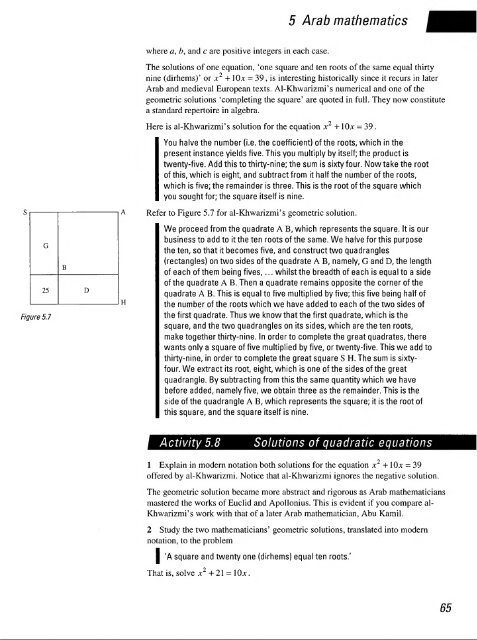history of mathematics - National STEM Centre
history of mathematics - National STEM Centre
history of mathematics - National STEM Centre
You also want an ePaper? Increase the reach of your titles
YUMPU automatically turns print PDFs into web optimized ePapers that Google loves.
25<br />
Figure 5.7<br />
where a, b, and c are positive integers in each case.<br />
5 Arab <strong>mathematics</strong><br />
The solutions <strong>of</strong> one equation, 'one square and ten roots <strong>of</strong> the same equal thirty<br />
nine (dirhems)' or x2 + lOx = 39, is interesting historically since it recurs in later<br />
Arab and medieval European texts. Al-Khwarizmi's numerical and one <strong>of</strong> the<br />
geometric solutions 'completing the square' are quoted in full. They now constitute<br />
a standard repertoire in algebra.<br />
Here is al-Khwarizmi's solution for the equation x 2 + lOx = 39.<br />
You halve the number (i.e. the coefficient) <strong>of</strong> the roots, which in the<br />
present instance yields five. This you multiply by itself; the product is<br />
twenty-five. Add this to thirty-nine; the sum is sixty four. Now take the root<br />
<strong>of</strong> this, which is eight, and subtract from it half the number <strong>of</strong> the roots,<br />
which is five; the remainder is three. This is the root <strong>of</strong> the square which<br />
you sought for; the square itself is nine.<br />
Refer to Figure 5.7 for al-Khwarizmi's geometric solution.<br />
We proceed from the quadrate A B, which represents the square. It is our<br />
business to add to it the ten roots <strong>of</strong> the same. We halve for this purpose<br />
the ten, so that it becomes five, and construct two quadrangles<br />
(rectangles) on two sides <strong>of</strong> the quadrate A B, namely, G and D, the length<br />
<strong>of</strong> each <strong>of</strong> them being fives,... whilst the breadth <strong>of</strong> each is equal to a side<br />
<strong>of</strong> the quadrate A B.Then a quadrate remains opposite the corner <strong>of</strong> the<br />
quadrate A B. This is equal to five multiplied by five; this five being half <strong>of</strong><br />
the number <strong>of</strong> the roots which we have added to each <strong>of</strong> the two sides <strong>of</strong><br />
the first quadrate. Thus we know that the first quadrate, which is the<br />
square, and the two quadrangles on its sides, which are the ten roots,<br />
make together thirty-nine. In order to complete the great quadrates, there<br />
wants only a square <strong>of</strong> five multiplied by five, or twenty-five. This we add to<br />
thirty-nine, in order to complete the great square S H. The sum is sixty-<br />
four. We extract its root, eight, which is one <strong>of</strong> the sides <strong>of</strong> the great<br />
quadrangle. By subtracting from this the same quantity which we have<br />
before added, namely five, we obtain three as the remainder. This is the<br />
side <strong>of</strong> the quadrangle A B, which represents the square; it is the root <strong>of</strong><br />
this square, and the square itself is nine.<br />
Activity 5.8 Solutions <strong>of</strong> quadratic equations<br />
1 Explain in modern notation both solutions for the equation x + \Qx = 39<br />
<strong>of</strong>fered by al-Khwarizmi. Notice that al-Khwarizmi ignores the negative solution.<br />
The geometric solution became more abstract and rigorous as Arab mathematicians<br />
mastered the works <strong>of</strong> Euclid and Apollonius. This is evident if you compare al-<br />
Khwarizmi's work with that <strong>of</strong> a later Arab mathematician, Abu Kamil.<br />
2 Study the two mathematicians' geometric solutions, translated into modern<br />
notation, to the problem<br />
| 'A square and twenty one (dirhems) equal ten roots.'<br />
That is, solve x 2 +21 = 10x.<br />
65
















